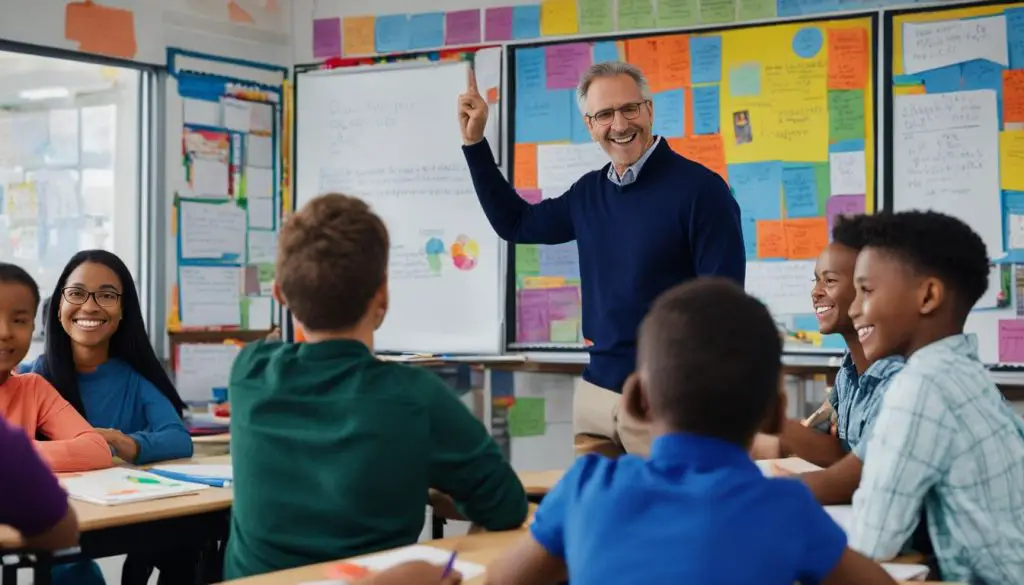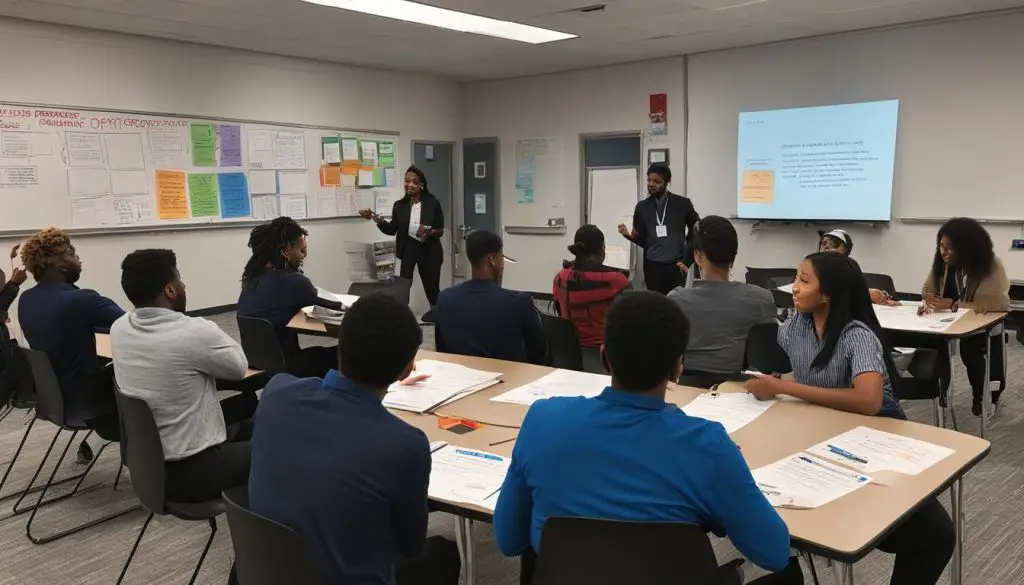
Engaging students in classroom discussions is a vital component of fostering a positive learning environment and promoting active learning. However, it can sometimes be challenging to encourage all students to actively participate and share their thoughts.
In this article, I will answer the question: “How can I get my students to talk to me more during class?”, I will provide you with effective strategies and insights on how to increase student participation and improve classroom communication. By implementing these strategies, you will be able to boost student engagement, enhance student-teacher interaction, and create a more dynamic and interactive learning experience for your students.
By fostering a classroom environment that encourages student engagement and promotes open communication, you can create an atmosphere where students feel comfortable expressing their ideas and opinions. This not only enhances their learning experience but also helps them develop vital communication and critical thinking skills.
Key Takeaways:
- Implement strategies increasing student participation and promote active learning
- Encourage open communication and create a positive learning environment
- Utilize effective questioning techniques to initiate meaningful conversations
- Explore tools and games that can improve classroom communication and engagement
- Enhance student-teacher interaction through cooperative learning activities and nonverbal communication techniques
Understanding the Importance of Student Participation
Student participation plays a pivotal role in creating an engaging and dynamic classroom environment. When students actively participate in class discussions and activities, they become more invested in their learning. This section will delve into the significance of student participation and how it positively impacts learning outcomes. By understanding the importance of student participation, educators can implement effective strategies to foster a collaborative and interactive learning experience.
List of Tools and Games to Improve Classroom Communication
Enhancing classroom communication can be achieved through various tools and games that promote student engagement. These interactive resources encourage students to express their thoughts, ideas, and opinions in a fun and stimulating way. Incorporating technology, such as online polling platforms or educational apps, can augment classroom communication. Additionally, games like role-playing activities, structured debates, and group projects foster effective communication skills among students. By utilizing these tools and games, teachers can create an interactive learning environment that encourages active participation and collaboration.
Challenges and Benefits of Fostering Classroom Communication
Fostering classroom communication may present challenges for educators, but the benefits far outweigh them. Some challenges include student shyness, language barriers, and differing communication styles. However, by overcoming these obstacles, teachers can unlock numerous benefits.
Improved classroom communication promotes critical thinking, deepens understanding of complex concepts, and enhances problem-solving skills. It fosters a sense of community and belonging among students, encouraging positive relationships and empathy.
Effective classroom communication also cultivates active listening skills and respect for diverse viewpoints. By addressing these challenges and recognizing the benefits, teachers can create an inclusive and communicative learning environment.
List of Questions to Start a Conversation with Students
Starting conversations with students can sometimes be daunting. However, asking open-ended questions is an effective way to initiate meaningful discussions and encourage student participation. Here is a list of questions to spark dialogue:
- What are your thoughts on [topic]?
- Can you provide an example of [concept]?
- How would you approach [problem]?
- What do you think is the significance of [event]?
- Why do you believe [theory] is important?
- What challenges do you foresee in [project]?
- How can we apply [idea] in real life?
- What are the pros and cons of [decision]?
These questions encourage critical thinking, reflection, and active participation, providing a platform for students to voice their opinions and engage in meaningful conversations.
Strategies to Increase Engagement and Encourage Discussion

In order to create a vibrant and interactive learning environment, it is essential to implement effective strategies that increase student engagement and encourage meaningful discussion in the classroom.
By fostering active learning and adopting student-centered teaching approaches, educators can create an inclusive space where students feel empowered to participate and share their thoughts. Cooperative learning activities further promote collaboration and teamwork among students, enhancing their overall learning experience.
To promote active learning, educators can incorporate various techniques such as:
- Implementing group projects or collaborative assignments that require students to work together towards a common goal.
- Encouraging open-ended questions that stimulate critical thinking and invite discussion.
- Integrating technology tools and educational games that promote interactive learning experiences.
- Creating a safe and supportive classroom environment that encourages students to take risks and express their opinions.
Furthermore, student-centered teaching approaches involve shifting the focus from the teacher to the students, allowing them to actively participate in the learning process. This can be achieved by:
- Providing opportunities for students to take on leadership roles and guide their own learning.
- Implementing hands-on activities and real-world examples that connect classroom lessons to students’ interests and experiences.
- Facilitating discussions and debates that encourage students to think critically and defend their viewpoints.
Cooperative learning activities promote collaboration, teamwork, and effective communication skills. Educators can promote cooperative learning by:
- Assigning group projects or tasks that require students to work together and share their knowledge.
- Implementing structured discussions or debates where students engage in respectful dialogue and actively listen to their peers.
- Encouraging peer feedback and peer teaching, where students learn from and support each other.
By implementing these strategies and creating an interactive learning environment, educators can increase student engagement, foster discussion, and promote active learning in the classroom.
Creating a Positive Learning Environment for Student Expression
In this section, I will share strategies for creating a positive learning environment that encourages student expression. Fostering a classroom culture where students feel comfortable and confident in sharing their thoughts and ideas is essential for their academic growth and personal development.
Building a Community through Pairs and Squares
One effective way to build a sense of community in the classroom is through the use of pairs and squares activities. These activities involve pairing students up or forming small groups to discuss and collaborate on assignments or topics. By working together in these smaller settings, students can engage in meaningful conversations and learn from each other’s perspectives.
Utilizing Classroom Structures to Enhance Student-Teacher Interaction
Another strategy for enhancing student expression is through teacher-student interaction. Creating opportunities for one-on-one or small group discussions with students can promote a deeper understanding of their thoughts and ideas. By actively listening and providing constructive feedback, teachers can encourage and support student expression in a meaningful way.
Encouraging Nonverbal Communication to Keep Students Engaged. Tips and Tricks.
Nonverbal communication plays a crucial role in creating a positive learning environment. Teachers can use nonverbal cues such as facial expressions, body language, and gestures to convey interest, empathy, and encouragement to students. Additionally, incorporating visual aids, interactive technologies, and other engaging materials can captivate students’ attention and foster active participation in the classroom.
Here are some tips and tricks for enhancing nonverbal communication in the classroom:
- Maintain eye contact with students to establish a connection and show attentiveness.
- Use positive body language, such as open posture and friendly gestures, to create a welcoming atmosphere.
- Use visual aids, such as charts, diagrams, and props, to support verbal communication and engage students visually.
- Encourage active listening by nodding, smiling, and using other nonverbal cues to show understanding and interest.
- Allow for silence to give students time to process information and gather their thoughts.
By implementing these tips and tricks, teachers can create an inclusive and supportive learning environment that enhances student expression and engagement.
How can I get my students to talk to me more during class?
Encouraging active learning is essential to promote student engagement and participation in the classroom. One effective strategy to achieve this is through the use of the “Write, Pair, Share” activity. This activity involves asking students to individually write down their thoughts or answers to a question, then pairing them up to discuss their ideas with a partner, and finally sharing their insights with the whole class. By incorporating this activity into your lessons, you provide students with the opportunity to reflect on their thoughts, collaborate with their peers, and express their ideas more confidently.
Setting participation goals and utilizing talking pieces are additional techniques that can enhance student engagement and the quality of classroom discussions. By actively setting goals for student participation, such as encouraging each student to contribute at least one idea or question per class, you create a sense of accountability and motivation. Talking pieces, such as a small object or a designated speaking turn, can be passed around the classroom, ensuring that every student has a chance to speak and share their thoughts. These strategies foster an inclusive environment where students feel valued and empowered to participate.
Implementing wait time and authentically engaging with students are crucial for encouraging more student interaction. Sometimes, students need a moment to gather their thoughts and formulate their responses. By incorporating wait time, you allow students to process information and articulate their ideas without feeling rushed. Additionally, authentic engagement means actively listening to students, asking follow-up questions, and showing genuine interest in their contributions. This shows students that their thoughts are valued, making them more likely to share and actively participate in class discussions.
FAQ
Q: How can I get my students to talk to me more during class?
A: There are several strategies you can use to encourage student participation and improve classroom communication. Some effective approaches include creating a positive learning environment, utilizing student-centered teaching methods, implementing cooperative learning activities, and asking thoughtful questions to initiate meaningful conversations.
Q: What are some tools and games that can be used to improve classroom communication?
A: There are various tools and games that teachers can utilize to enhance classroom communication. Some examples include using interactive online platforms, implementing group discussion activities, incorporating technology tools like polling apps or discussion boards, and utilizing role-play or debate games to encourage student interaction.
Q: What are the challenges and benefits of fostering classroom communication?
A: Fostering classroom communication can come with challenges such as shy or reluctant students, maintaining balanced participation, and managing time for discussions. However, the benefits of promoting classroom communication outweigh these challenges as it enhances student engagement, critical thinking skills, collaboration, and a deeper understanding of the subject matter.
Q: What are some questions that teachers can ask to start a conversation with their students?
A: To initiate meaningful conversations, teachers can ask questions that prompt critical thinking and encourage students to share their thoughts. Some examples include asking open-ended questions, providing real-world scenarios and asking for student opinions, asking for personal reflections or experiences related to the topic, or using thought-provoking questions that challenge students to consider multiple perspectives.
Q: How can I increase student engagement and encourage discussion in the classroom?
A: To increase student engagement and encourage discussion, you can try student-centered teaching approaches such as group work, collaborative projects, or interactive presentations. Additionally, incorporating hands-on activities, incorporating technology tools, providing clear objectives and expectations, and offering positive reinforcement can further promote active learning and student participation.
Q: How can I create a positive learning environment that encourages student expression?
A: Creating a positive learning environment that encourages student expression involves building a classroom community where students feel safe to share their thoughts and ideas. Strategies such as implementing icebreaker activities, using classroom structures like pairs and squares, leveraging nonverbal communication techniques, and actively listening and engaging with students can create a supportive and inclusive atmosphere.
Q: What are some strategies for encouraging active learning and student participation?
A: Encouraging active learning and student participation can be achieved through various strategies. Some effective techniques include implementing activities like write, pair, share, setting participation goals and utilizing talking pieces to ensure everyone has a chance to contribute, implementing wait time to allow students to process and formulate their thoughts, and authentically engaging with students through personalized feedback and active listening.
Source Links
- https://www.commonlit.org/blog/6-simple-ways-to-get-your-students-talking-78ef0d58d51a/
- https://www.thoughtco.com/getting-students-to-talk-in-class-3860770
- https://www.edutopia.org/article/9-strategies-getting-more-students-talk/
- https://www.myenglishteacher.eu/blog/difference-between-talk-to-me-and-talk-with-me/


























